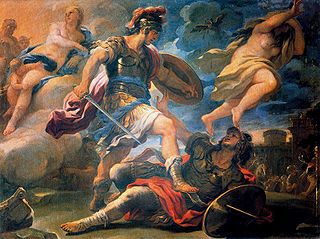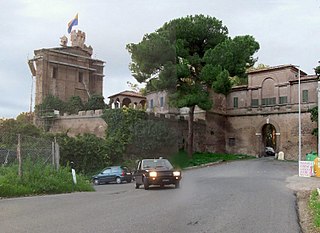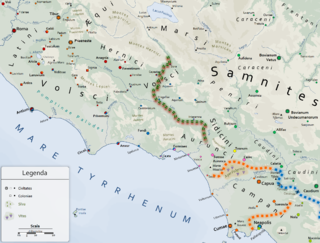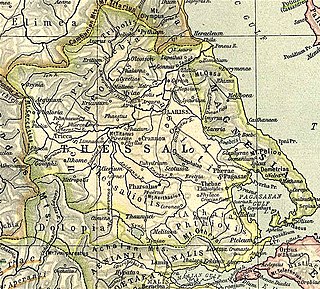
In Greco-Roman mythology, Aeneas was a Trojan hero, the son of the Trojan prince Anchises and the Greek goddess Aphrodite. His father was a first cousin of King Priam of Troy, making Aeneas a second cousin to Priam's children. He is a minor character in Greek mythology and is mentioned in Homer's Iliad. Aeneas receives full treatment in Roman mythology, most extensively in Virgil's Aeneid, where he is cast as an ancestor of Romulus and Remus. He became the first true hero of Rome. Snorri Sturluson identifies him with the Norse god Víðarr of the Æsir.

Ascanius was a legendary king of Alba Longa and the son of the Trojan hero Aeneas and Creusa, daughter of Priam. He is a significant figure in Roman mythology because of his genealogy: as the son of the Roman founding father Aeneas, himself the son of the goddess Venus and the Trojan prince Anchises, he was regarded as an ancestor of the Roman people. Under his additional name Iulus, he was claimed as the particular ancestor of the gens Iulia, the family of Julius Caesar, and therefore a progenitor of the first line of Roman emperors, the Julio-Claudian dynasty. In some Roman genealogies, he is also made to be an ancestor of Romulus and Remus. Together with his father, he is a major character in Virgil's Aeneid.

Turnus was the legendary King of the Rutuli in Roman history, and the chief antagonist of the hero Aeneas in Virgil's Aeneid.

In Roman mythology, Lavinia is the daughter of Latinus and Amata, and the last wife of Aeneas.

RheaSilvia, also known as Ilia, was the mythical mother of the twins Romulus and Remus, who founded the city of Rome. This event was portrayed numerous times in Roman art. Her story is told in the first book of Ab Urbe Condita Libri of Livy and in Cassius Dio's Roman History. The Legend of Rhea Silvia recounts how she was raped by Mars while she was a Vestal Virgin, resulting in the twins, as mentioned in the Aeneid and the works of Ovid.

Lavinium was a port city of Latium, 6 km (3.7 mi) to the south of Rome, midway between the Tiber river at Ostia and Antium. The coastline then, as now, was a long strip of beach. Lavinium was on a hill at the southernmost edge of the Silva Laurentina, a dense laurel forest, and the northernmost edge of the Pontine Marshes, a vast malarial tract of wetlands. The basis for the port, the only one between Ostia and Antium, was evidently the mouth of the Numicus river.

According to the Roman foundation myth, Titus Tatius, also called Tatius Sabinus, was king of the Sabines from Cures and joint-ruler of the Kingdom of Rome for several years.

The Liri is one of the principal rivers of central Italy, flowing into the Tyrrhenian Sea a little below Minturno under the name Garigliano.

The Ficus Ruminalis was a wild fig tree that had religious and mythological significance in ancient Rome. It stood near the small cave known as the Lupercal at the foot of the Palatine Hill and was the spot where according to tradition the floating makeshift cradle of Romulus and Remus landed on the banks of the Tiber. There they were nurtured by the she-wolf and discovered by Faustulus. The tree was sacred to Rumina, one of the birth and childhood deities, who protected breastfeeding in humans and animals. St. Augustine mentions a Jupiter Ruminus.

The rape of the Sabine women, also known as the abduction of the Sabine women or the kidnapping of the Sabine women, was an incident in the legendary history of Rome in which the men of Rome committed a mass abduction of young women from the other cities in the region. It has been a frequent subject of painters and sculptors, particularly since the Renaissance.

The Aurunci were an Italic tribe that lived in southern Italy from around the 1st millennium BC. They were eventually defeated by Rome and subsumed into the Roman Republic during the second half of the 4th century BC.

The kings of Alba Longa, or Alban kings, were a series of legendary kings of Latium, who ruled from the ancient city of Alba Longa. In the mythic tradition of ancient Rome, they fill the 400-year gap between the settlement of Aeneas in Italy and the founding of the city of Rome by Romulus. It was this line of descent to which the Julii claimed kinship. The traditional line of the Alban kings ends with Numitor, the grandfather of Romulus and Remus. One later king, Gaius Cluilius, is mentioned by Roman historians, although his relation to the original line, if any, is unknown; and after his death, a few generations after the time of Romulus, the city was destroyed by Tullus Hostilius, the third King of Rome, and its population transferred to Alba's daughter city.

Romulus was the legendary founder and first king of Rome. Various traditions attribute the establishment of many of Rome's oldest legal, political, religious, and social institutions to Romulus and his contemporaries. Although many of these traditions incorporate elements of folklore, and it is not clear to what extent a historical figure underlies the mythical Romulus, the events and institutions ascribed to him were central to the myths surrounding Rome's origins and cultural traditions.
Bolae or Bola was an ancient city of Latium that was repeatedly mentioned in the early history of Rome. It was likely located in the territory of the modern town of Labico.
Cameria or Camerium was an ancient city of Latium, which according to tradition was conquered by Rome in the time of the Kings, and destroyed following a revolt against Roman authority in 502 BC. Its inhabitants were known as Camerini.

Alba Longa was an ancient Latin city in Central Italy in the vicinity of Lake Albano in the Alban Hills. The ancient Romans believed it to be the founder and head of the Latin League, before it was destroyed by the Roman Kingdom around the middle of the 7th century BC and its inhabitants were forced to settle in Rome. In legend, Romulus and Remus, founders of Rome, had come from the royal dynasty of Alba Longa, which in Virgil's Aeneid had been the bloodline of Aeneas, a son of Venus.
Old Latium is a region of the Apennine Peninsula bounded to the north by the Tiber River, to the east by the central Apennine Mountains, to the west by the Mediterranean Sea and to the south by Monte Circeo. It was the territory of the Latins, an Italic tribe which included the early inhabitants of the city of Rome. Later it was also settled by various Italic tribes such as the Rutulians, Volscians, Aequi, and Hernici. The region was referred to as "old" to distinguish it from the expanded region, Latium, that included the region to the south of Old Latium, between Monte Circeo and the river Garigliano – the so-called Latium adiectum. It corresponded to the central part of the modern administrative region of Lazio, Italy, and it covered an area measuring of roughly 50 Roman miles. It was calculated by Mommsen that the region's area was about 1860 square kilometres.
Laurent is a French masculine given name of Latin origin. It is used in France, Canada, and other French-speaking countries. The name was derived from the Roman surname Laurentius, which meant "from Laurentum". It can also be derived from the Old Greek word Lavrenti, meaning "the bright one, shining one". Laurentum was an ancient Roman city of Latium situated between Ostia and Lavinium, on the west coast of the Italian peninsula southwest of Rome, and its name is either descended from many groves of Laurus nobilis, or, according to Virgil, a single "sacred" laurel tree. The feminine form of Laurent is Laurence.

Meliboea or Meliboia was a town and polis (city-state) of Magnesia in ancient Thessaly, mentioned by Homer, in the Catalogue of Ships in the Iliad, as one of the places subject to Philoctetes. It was situated upon the sea coast, and is described by Livy as situated at the roots of Mount Ossa, and by Strabo as lying in the gulf between Mount Ossa and Mount Pelion.
The gens Tatia was a minor plebeian family at ancient Rome. This gens is perhaps best known from the legendary figure of Titus Tatius, a Sabine king who fought against Romulus, and who subsequently became joint ruler of Rome. None of the Tatii held any of the higher magistracies of the Roman Republic, but a number are known from inscriptions.















